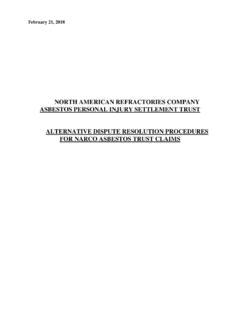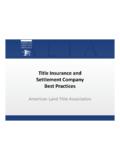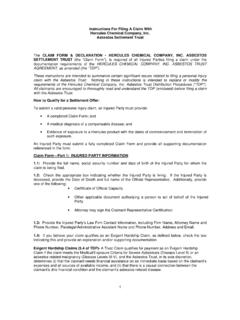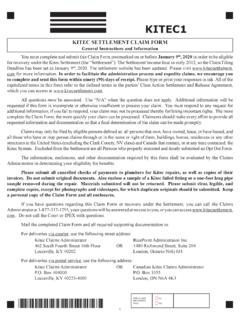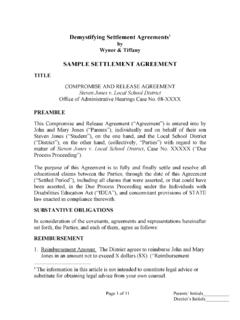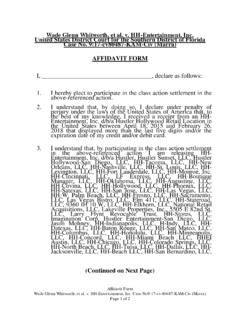Transcription of SHORTENING THE SETTLEMENT CYCLE: THE MOVE …
1 1 SHORTENING THE SETTLEMENT cycle : THE MOVE TO T+2 This information in this report was prepared by PricewaterhouseCoopers LLP (PwC) in conjunction with the Industry Steering Committee (ISC) and as commissioned by The Depository Trust & Clearing Corporation (DTCC). It has been prepared for general guidance on matters of interest only, and does not constitute professional advice. You should not act upon the information contained in this publication without obtaining specific professional advice. PwC has exercised reasonable professional care and diligence in the collection, processing, and reporting of information. However, some of the information used is from third-party sources and PwC has not independently verified, validated, or audited the information. No representation or warranty, express or implied, is given as to the accuracy or completeness of the information contained in this report, and, to the extent permitted by law, PwC, its members, employees and agents do not accept or assume any liability, responsibility or duty of care for any consequences of you or anyone else acting, or refraining to act, in reliance on the information contained in this publication or for any decision based on trademarks included are trademarks of their respective owners and are not affiliated with, nor endorsed by, PricewaterhouseCoopers STEERING COMMITTEE: PARTICIPATING INDUSTRY ASSOCIATIONSThe Industry Steering Committee consists of the following industry associations:The Association of Global Custodians (AGC) The Association of Institutional INVESTORS (AII)Investment Company Institute (ICI)The Securities Transfer Association, Inc.
2 (STA)The Securities Industry and Financial Markets Association (SIFMA)The Depository Trust& Clearing Corporation4 CONTENTSEXECUTIVE SUMMARY ..5 SHORTENING THE SETTLEMENT cycle ..7A Brief History ..7 Why T+2 ..8 Industry Action ..9 PROPOSED T+2 MIGRATION TIMELINE ..11 MIGRATING TO T+2 ..13 Product Scope ..13 Industry-Level Requirements ..13 Requirements Catalog ..15 Trade Processing ..17 Asset Servicing ..22 Documentation ..24 Regulatory PRACTICES AND OTHER INDUSTRY INITIATIVES ..28 NEXT STEPS ..30 CONCLUSION ..31 APPENDIX ..32T+3 TRADE PROCESSING WORKFLOW ..32 GLOSSARY ..33 INDUSTRY PARTICIPANTS ..35 5 EXECUTIVE SUMMARYF ollowing the 2008 financial crisis, the industry has increased its focus on reducing risk, achieving greater transparency, and improving efficiency in order to establish a safer market environment. The crisis led to a host of regulations and initiatives impacting markets, products, and participants. SHORTENING the SETTLEMENT cycle , while not a regulatory mandate in the United States, is an industry effort that is expect-ed to yield important benefits including reduced counterparty risk, decreased clearing capital requirements, reduced pro-cyclical margin and liquidity demands, and increased global SETTLEMENT harmonization.
3 Major markets across the globe either are examining a move to a two-day SETTLEMENT period (T+2) (Canada and Japan), are currently moving to T+2 (Australia), or have already completed a move to T+2 (European Union, Hong Kong, and South Korea). In early 2012, the Boston Consulting Group (BCG) conducted an independent study, commissioned by The Depository Trust & Clearing Corporation (DTCC), to analyze the costs, benefits, opportunities, and challenges associated with SHORTENING the SETTLEMENT cycle in the market to T+1 or T+2. This study confirmed the risk reduction benefits, operational efficiencies, and feasibility of a move to T+2 SETTLEMENT for equities, corporate bonds, municipal bonds, and unit investment trusts. Following the 2012 study, the industry, led by various associations including the Invest-ment Company Institute (ICI), the Association of Global Custodians (AGC), the Association of Institutional INVESTORS (AII), and the Securities Industry and Financial Markets Association (SIFMA), expressed support for a move to T+ an initial step in the migration to T+2, the financial services industry formed an Industry Steering Committee (ISC), Industry Working Group (IWG), and Sub-Working Groups (SWGs).
4 The ISC, which provides oversight and guidance, developed a proposed migration timeline outlining the necessary activities required to complete a move to T+2 by Q3 2017. The 2017 implementation timeframe was established based on industry analysis performed by the ISC and IWG and is contingent upon obtaining regulatory certainty in a timely manner and successfully completing industry-wide testing. Regulatory certainty is critical because some organizations may not be willing or able to commit the resources required to complete a move to T+2. Industry participants also may have diverse views on what denotes regulatory certainty. They may associate this with regulatory support and priority for the industry move to T+2, the publication of proposed rules, or the publication of final rule changes by the ISC considered these perspectives and identified four critical milestones related to the regulatory changes necessary to effectuate the move to T+2: Q2 2015: ISC recommends rule changes to regulators Q3 2015: Regulators provide regulatory support and priority for the move to T+2 Q4 2015: Regulators publish proposed rule changes Q2 2016: Regulators publish final rule changes and implementation datesThe first milestone was completed in the timeframe identified.
5 A delay in achieving the remaining regulatory mile-stones is likely to impact the targeted Q3 2017 implementation timeframe. Furthermore, successful completion of broad and comprehensive industry-wide testing, planned for Q2 and Q3 of 2017, is vital to the T+2 effort, as organiza-tions will need to ensure their processes and systems function properly in a T+2 environment. 6 The IWG and SWGs identified and assessed the regulatory changes and industry-level requirements to facilitate a move to T+2 for equities, corporate bonds, municipal bonds, unit investment trusts, and financial instruments com-prised of these products. These industry-level requirements are grouped into four areas: TRADE PROCESSING: Requirements for trade processing activities including reference data setup, real time trade matching, straight-through processing, and the delivery of physical securities ASSET SERVICING: Requirements related to asset servicing functions that include ex-date and cover/protect period computations for corporate actions DOCUMENTATION: Requirements related to agreements and procedural documentation REGULATORY CHANGES: Regulatory rule changes that will be necessary for migration to T+2 The industry-level requirements are meant to provide each organization with a foundation to determine individual impacts, perform due diligence, and develop detailed requirements.
6 It should be noted, however, that the industry-lev-el requirements will impact individual organizations differently and may result in numerous entity-level requirements that are not captured in this document. As the industry moves forward with the T+2 migration effort, additional industry-level requirements also may be identified, which will be communicated to stakeholders by the ISC. The IWG and SWGs also identified industry considerations, leading practices and other industry initiatives. The industry considerations include failed trade management, securities lending, liquidity and collateral management, processing of multi-listed securities, foreign investment/cross-border transactions, and secondary insurance for municipal bonds. The leading practices focus on trade date match/affirm, automated exchange of standing SETTLEMENT instructions, electronic funds payment/Automated Clearing House (ACH) processing and early and ongoing stakeholder communi-cation. Other industry initiatives identified include extending digital delivery and use of the summary prospectus delivery option, dematerialization, and Automated Customer Account Transfer Service (ACATS) enhancements.
7 It is recommended that organizations review each of these areas and determine impacts to internal processes and proce-dures, seek practice improvements, and support other industry initiatives that facilitate operational efficiencies and cost savings for the industry. The T+2 effort until now has been driven by the ISC, IWG, and SWGs. However, as the effort progresses, involvement of participants, in addition to the continued leadership from the ISC, IWG, and SWGs, will be necessary for a successful migration. Organizations involved in the trade lifecycle of the in-scope products should assess the information presented in this document to conduct an internal impact assessment, and develop organization-level requirements and internal implementation plans. The ISC will continue supporting this effort by engaging with the regulators, providing governance, and monitoring the T+2 migration progress. The IWG will work in conjunction with the ISC to communicate the proposed implementation and testing plan to industry participants.
8 Organizations are encouraged to engage with the ISC to stay well informed of T+2 developments and ensure readiness for T+2 migration by Q3 2017. 7 SHORTENING THE SETTLEMENT cycle CONFIDENTIAL DRAFT Figure 1 1 1987 Market disruptions drive analysis on SHORTENING the SETTLEMENT cycle 1995 SEC Rule 15c6-1 mandates T+3 SETTLEMENT for a variety of asset classes Focus on improving clearing and SETTLEMENT for the move to T+3 Discussions on SHORTENING the SETTLEMENT cycle to T+2 or T+1 Late 90 s Industry discussions continue on further SHORTENING the SETTLEMENT cycle Emphasis on enabling STP 2004 SEC concept release on improving operational efficiency of SETTLEMENT and clearing 2008 Global financial crisis spurs regulations to reduce systemic and operational risk 2012 EU decides to move to T+2 SETTLEMENT in 2014 2012 DTCC commissions cost benefit analysis of move to T+1 or T+2 2014 Industry associations expressed support for move to T+2 Focus on SHORTENING the SETTLEMENT cycle to T+2 2014 EU1 moves to T+2 on October 6th US T+2 effort discovery and analysis phase 1 Spain is expected to complete the migration to T+2
9 SETTLEMENT in Q4 2015 2011 Hong Kong introduces T+2 Finality on July 25th Figure 1: History of SHORTENING the SETTLEMENT cycle in the Brief HistorySince Black Monday 1 in 1987, the industry has been seeking to reduce risk (credit, market, and liquidity risk) by SHORTENING the SETTLEMENT cycle . In 1995, the Securities and Exchange Commission (SEC or Commission) adopted Rule 15c6-1 under the Securities Exchange Act of 1934, which resulted in the migration from T+5 to T+3 SETTLEMENT for a variety of asset classes. Following the introduction of T+3 SETTLEMENT , regulators and industry participants continued to discuss further SHORTENING the SETTLEMENT cycle . The financial crisis of 2008 prompted a host of global regulations and recommendations such as the Dodd Frank Act2, EMIR3, MiFID,4 and BCBS IOSCO5 to address and mitigate systemic risk. The response also included the European Commission s 2012 decision to harmonize SETTLEMENT cycles in Europe and move to T+2 SETTLEMENT . 6 Correspondingly, DTCC issued a white paper in 2012 titled The Role of DTCC in Mitigating Systemic Risk, 7 which recommended a cost benefit study to assess the impact of a shortened SETTLEMENT cycle (SSC).
10 The study, conducted by BCG, revealed broad 1 Black Monday refers to Monday, October 19, 1987, when global stock markets experienced significant declines. 2 Dodd-Frank Wall Street Reform and Customer Protection Act promotes the financial stability of the United States by improving accountability and transparency in the financial EMIR (European Market Infrastructure Regulation) is an EU regulation designed to increase the stability of the over-the-counter (OTC) derivative markets throughout the EU member MiFID (Markets in Financial Instruments Directive) establishes a regulatory framework for the provision of investment services in financial BCBS (Basel Committee on Banking Supervision) IOSCO (International Organization of Securities Commissions) framework addresses margin requirements for uncleared OTC derivatives On Oct 6, 2014, most markets in the migrated to T+2 standard SETTLEMENT . 7 To view the full white paper, please see: DTCC s The Role of DTCC in Mitigating Systemic Risk.
